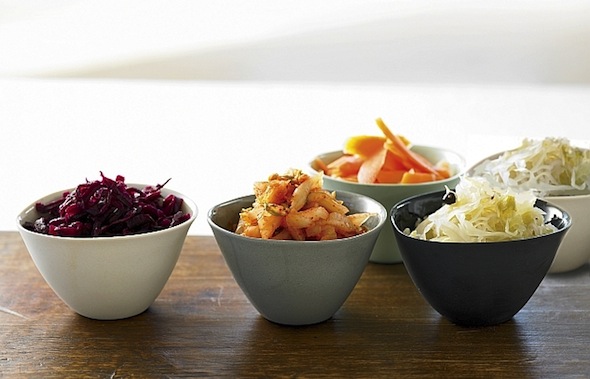My friends over at Wise Choice Market are experts at lacto-fermentation. Their specialty is fermented vegetables and vegetables juices that have the utmost quality and available nutrition. The parent company is Caldwell Bio Fermentation. For over 15 years, Caldwell Bio Fermentation has been using scientifically developed starter cultures and procedures to make high quality organic raw cultured vegetables, such as sauerkraut, red cabbage, carrots, beets, and kimchi. Caldwell also offers a unique starter culture for vegetables. I must say, I prefer the taste of sauerkraut when it is made with cultures, rather than just salt.
Lactic fermentation is an ancient method used by many peoples throughout the world for preserving food. Even before cultivating vegetables, man fermented wild plants.
Lacto-fermented cabbage was already known in China some six thousand years ago, and served as a staple food for those who built the Great Wall of China. Captain Cook’s sailors were fed fermented cabbage on their voyages, since it was well known at that time as an effective way to prevent scurvy.
Many peoples, in particular the Koreans, the Japanese, and the Northern and Central Europeans, have used lactic fermentation as a practical method of preservation, as well as for the particular flavor the process gives to foods.
Other examples of traditional fermented vegetable products include pickled cucumbers, red cabbage, carrots, radishes, and beets. Today the dish known as “sauerkraut” is still the German national dish, and is also widely consumed in the USA.
Food preservation methods today
With the development of pasteurization and freezing as methods of preservation, the more traditional technique of lacto-fermentation has fallen into disuse in most “developed” countries.
It has become standard practice for commercial producers of sauerkraut and other fermented vegetables to pasteurize their products, or to add chemical preservatives to increase their stability and extend their shelf life.
Some manufacturers even forgo the fermentation stage altogether, opting to use vinegar or added lactic acid instead. These shortcuts may offer economies for large scale production, but result in inferior products that are devoid of live bacteria and active enzymes, and lack the distinctive taste and texture of the traditional raw fermented versions.
The following table compares the attributes of fresh cut vegetables, regular commercial pickles and raw lacto-fermented vegetables:
| Attribute |
Fresh cut vegetables |
Commercial |
Raw lacto-fermented |
| Storage |
Chilled |
Ambient |
Chilled or in cool, dark place |
| Shelf life |
Short |
Long |
Long |
| Additives |
None |
Sometimes |
None |
| Cooked/pasteurized |
No |
Yes |
No |
| Salt content |
None |
High |
Medium |
| Contains lactic acid bacteria |
No |
No |
Yes |
Nutritional Benefits
Freshly harvested vegetables contain fiber, minerals, trace elements and vitamins, the last of which are often destroyed or significantly damaged by commercial processing. Raw vegetables that are lacto-fermented retain all these components, and also contain active enzymes, live lactic acid bacteria and lactic acid.
Numerous health benefits have been reported throughout with regard to fermented vegetables and their lactic bacteria. While many of these health claims remain to be demonstrated clinically, various scientific and government bodies around the world endorse the ‘functional’ properties of fermented foods). Live lactic acid bacteria are claimed to contribute to the protection of the body against infections, stimulate the immune system, ease the digestion, and facilitate the synthesis of B vitamins.
Production Process
Traditional lacto-fermentation relies on naturally occurring beneficial bacteria, the Lactobacilli, which are similar to cultures used to make yoghurt and sourdough bread. Lactobacilli break down the sugars in fruit and vegetables and produce lactic acid, which acts as a natural preservative.
First, fresh fruits or vegetables are washed and cut into pieces. They are then mixed with a small amount of sea salt, which draws out the juices; preserves the fruits or vegetables while the fermentation gets started, and helps to regulate the fermentation process.
The mixture is then packed into airtight fermentation vessels and placed in a warm place to ferment. The final acidity at the end of a successful fermentation process effectively inhibits pathogenic bacteria, and preserves the vegetables for out‑of‑season use.
Once the initial fermentation is finished and the desired acidity is achieved, the products can be left in the fermentation vessels, or repackaged into smaller airtight containers, and transferred to a low temperature area for a period of maturation and storage.
Challenges
The quantity of naturally occurring bacteria present on the surfaces of fresh fruits and vegetables can vary for many reasons. Traditional lacto-fermentation is therefore an uncontrolled process, and the results are often inconsistent.
The outcome depends on the available levels of these bacteria, and on several other factors that can affect the quality, consistency and safety of the final product, including vegetable freshness and quality, fermentation time, temperature, and salt quality and content. In order to ensure that lacto-fermentation provides a consistent supply of safe and nutritious food, the fermentation process must be correctly regulated.
Solutions
The stabilization and control of traditional lacto-fermented vegetable production requires a scientific approach. Microbiologists at major research centers worldwide are continuing to study the complex workings of traditional lacto-fermentations of vegetables and fruits.
This research has found that an important requirement is the use of mixed-strain starter cultures that contain the appropriate bacterial strains for vegetable fermentation in the correct proportions.
These starter cultures, together with precisely controlled fermentation techniques and conditions, result in shortened fermentation time, reduction or elimination of secondary fermentation (‘fizziness’), reduction of salt levels (compared to commercial pickles), and consistent, stable production on a small or large scale.
Products made using these starter cultures retain the flavor, color and texture of traditionally fermented vegetables, as well as all their important health benefits.
Where to purchase Wise Choice Market Caldwell culture starters, fermented juices and frozen fermented vegetables.
Stop by for the giveaway of Caldwell’s Cultured Vegetable Juices generously sponsored by Wise Choice Market!













